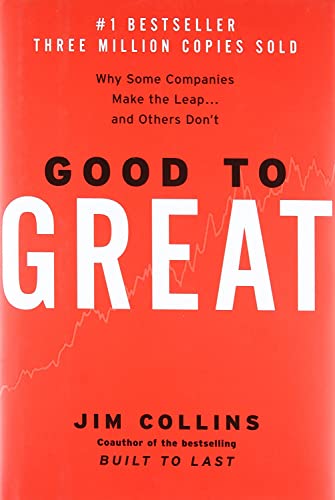Title: Good to Great: Why Some Companies Make the Leap… and Others Don’t
Author: Jim Collins
Overview:
“Good to Great” by Jim Collins is a comprehensive study of why some companies achieve greatness and sustained success while others do not. Collins and his research team embarked on a five-year project to identify the factors that distinguish “great” companies from merely “good” ones. The book presents a systematic analysis of their findings, revealing key principles and strategies that can transform an organization from good to great.
Key Concepts and Insights:
Level 5 Leadership: Collins introduces the concept of Level 5 Leadership, which represents leaders who blend personal humility with professional will. Level 5 leaders are characterized by their commitment to the success of the organization rather than personal ego.
The Hedgehog Concept: The Hedgehog Concept emphasizes simplicity and focus. Great companies concentrate on what they can be the best at (their “hedgehog”), are deeply passionate about it, and align their resources and efforts accordingly.
The Stockdale Paradox: Named after Admiral James Stockdale, this concept highlights the importance of confronting the brutal facts of a situation while maintaining an unwavering belief in ultimate success. Successful companies have a realistic assessment of their challenges but maintain optimism about the future.
The Flywheel: Collins introduces the concept of the flywheel, a self-reinforcing loop of activities that, when consistently executed over time, leads to dramatic results. Companies that achieve greatness build and maintain their flywheel through disciplined actions.
Technology Accelerators: Great companies use technology as an accelerator of their chosen strategies, rather than as a primary driver of change. Technology should support the core business, not lead it.
The Culture of Discipline: Collins emphasizes the importance of a disciplined culture where people adhere to the company’s core values and strategic objectives. Discipline is seen as a consistent practice rather than a reaction to crises.
The “Stop Doing” List: Companies that make the leap from good to great often engage in disciplined decision-making, which includes the ability to identify and stop activities that do not align with their Hedgehog Concept.
The Transition: Collins discusses the critical phase of leadership transition and the importance of ensuring that the company continues to excel under new leadership.
Real-World Examples:
The book provides numerous real-world examples and case studies of companies that successfully applied these principles to achieve greatness, including Walgreens, Kimberly-Clark, and Nucor. It also contrasts these companies with those that failed to make the leap.
Impact:
“Good to Great” has had a profound impact on leadership and management practices. It has become a classic in the business literature, influencing executives and entrepreneurs worldwide. The book’s insights continue to be relevant for those seeking to build enduring and exceptional organizations.
In summary, “Good to Great” offers a roadmap for organizations to transcend mediocrity and achieve long-term greatness through disciplined leadership, strategic focus, and a commitment to core principles.








